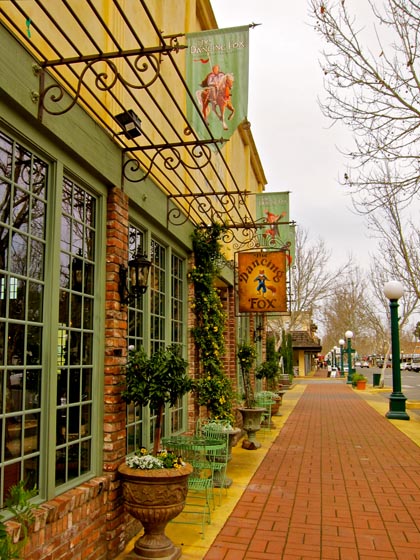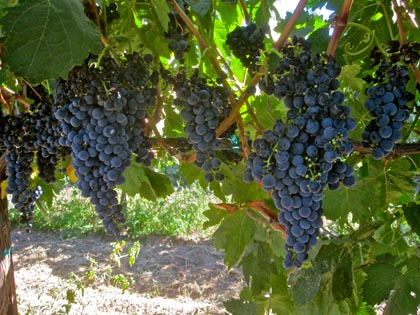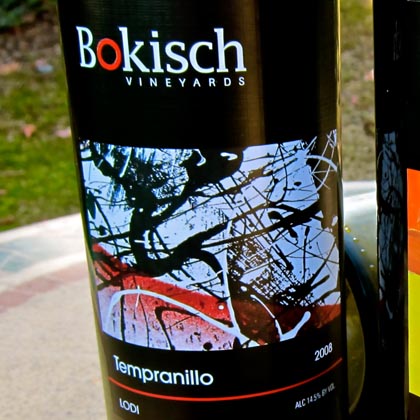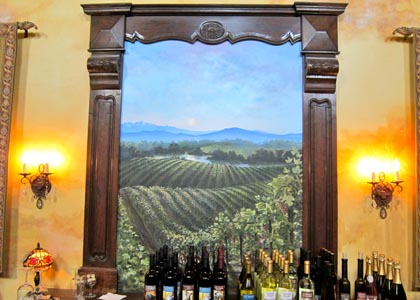Letters from Lodi
An insightful and objective look at viticulture and winemaking from the Lodi
Appellation and the growers and vintners behind these crafts. Told from the
perspective of multi-award winning wine journalist, Randy Caparoso.
Lodi Tempranillo takes the cake
Dancing Fox's Gregg Lewis
Who is that gaucho, amigo, why is he standing there in your spangled leather poncho? Suddenly Lodi has a shiny new wine producing specialist in town; although not totally “new,” because he’s been nursing wine grapes here since the late nineties, at the far western edge of Lodi’s Clements Hills AVA, where the Mokelumne River flows from the Sierra Foothills through rolling, idyllic 400-600 ft. hills topped with alluvial soils on clay loams.
Colleen Lewis, boulanger
Nevertheless, the just released 2008 Dancing Fox Old Father Vine Clements Hills Tempranillo ($25) represents winemaker/proprietor Gregg Lewis first varietal bottling of this grape; and in a word, it’s a bronco-buster. In more words: dark purplish ruby color giving fair warning of a sensational, sweet cassis (that is, like luscious blackcurrants) and jammy blackberry aromas, the flavors of such couched in round, fleshy, juicy sensations, bouncing with dense, meaty qualities on the palate. Praise the lord and pass the grilled meats and vegetables!
Dancing Fox, as it were, is also an emerging Downtown Lodi landmark; the winery located right there on School St., fronted by a wine bar and bakery/restaurant where, going on two years, folks have been flocking to enjoy the foods and heart warming smells emanating from the kitchen/bakery manned six days a week by boulanger/co-proprietor Colleen Lewis. To describe the breads of Lewis’ better half as artisanal might be an understatement: few in the country go so far as her to achieve the perfect crusts and baby soft cores in a wood fired brick oven, milling some of her own flour, and even cultivating some of her own yeasts (from grapeskin flora!).
But if Mr. Lewis has been laboring as a winegrower on the far side of Lodi since the mid-eighties, what took him so long to start fashioning his own stellar Tempranillo? “Markus Bokisch is the one who first convinced me to plant this grape, just over ten years ago,” Lewis tells us. “We started with 2 acres, which turned out so well that we’ve since grafted over another 18 acres… and up until now, most of the grapes have been going to other wineries, located outside of Lodi, like Cinnabar, Cantara, Thomas Fogarty, Odisea, and Hawkes. The benefit, though, is when you have experienced winemakers like Cinnabar’s George Troquato spending a lot of time in your vineyard, advising you on things like shoot and cluster thinning — it’s like receiving high quality consulting and being paid for it!”
So let’s back up a little, and talk about Tempranillo; that is, what, wherefore and how it’s become still another grape distinguishing Lodi as a preeminent, cutting-edge wine region. If you’re not thoroughly familiar with Tempranillo, join the crowd. As classic a variety of Vitis vinifera (coming from the European family of wine grapes) as it may be, surprisingly little has been known about Tempranillo even by “experts” up until recently.
Tempranillo has been called the “Cabernet Sauvignon of Spain,” which is ridiculous because when you look at the classic Tempranillo based reds of Spain’s Rioja denominacións (or “regions of origin”), they do not have nearly the weight, saturated color and density of even run-of-the-mill cabernet based reds; and certainly not Cabernet Sauvignon’s propensity towards methoxy-pyrazines (the compounds that give cabernets their typical herbal, weedy, sometimes bell peppery and often minty aromas).
Ripken's gorgeous Lodi grown Tinta de Toro
Tempranillo was once seriously thought to be related to Pinot Noir, which was also ludicrous. Aside from soft, finesseful textures, Tempranillo based reds almost never have as high a natural acidity you find in even warmer climate grown Pinot Noir, and there certainly is little relation between the peppermint spiced red berry/strawberry perfume of typical pinots and the blacker berryish fruit qualities — tinged with notes of licorice, tobacco leaf, smoked meats and snapping leather — common to reds made from Tempranillo.
Like many classic European grapes, Tempranillo has been… just there, for a long, long time, very much an Iberian thing. They say that a Spanish poet named Alejandro-something wrote of the wonderful “Tempraniellas” grape grown in along the Duero River back in the thirteenth century. As in other European wine countries, for centuries Tempranillo was called by multiple names in different regions, each region thinking they were cultivating a grape unique and unto their own: Ull de Llebre in Catalonia, Tinta de Toro in Zamora, Cencibel in Valdepeñas, Tinto Fino in Ribera del Duero, Tinta Roriz or Aragonêz in Portugal, and even Valdepeñas in California.
Colleen Lewis' amazing pan rustico
Alas, during most of the last century American Tempranillo was grown mostly for anonymous “jug” wines, which is where they went. It wasn’t until the nineties that growths of any real consequence were put into the ground. In the early nineties a Rioja obsessed retired dermatologist named Earl Jones began searching up and down the West Coast for the closest approximation to the growing conditions of Spain — long, warm summer days to fully ripen a Tempranillo’s flavor, and sufficiently cool autumns and slopes to keep acidity and anthocynins (pigments that bind with and stabilize tannin) from dropping out — and settled in Southern Oregon’s Umpqua Valley, where he founded his Abacela estate. Indeed, Jones has been producing some damned good Tempranillo. Most recently: a beautifully dark, supple, densely textured 2007 Abacela Umpqua Valley Tempranillo, replete with concentrated blackberry and strawberry liqueur-like flavors.
Lodi has had its own Tempranillo visionaries. Beginning in 1980, the late, great Tim Spencer of Lodi’s St. Amant Winery pioneered Portuguese grapes in the lower foothills of Amador County. Tim and his son Stuart, St. Amant’s current winemaker/proprietor, did some major replantings in the latter part of the nineties; including Tinta Roriz, a Portuguese variant of Tempranillo. From this has come a number of triumphantly deep, dark, beefy, black fruit focused Tempranillo bottlings; proving that the grape can thrive just fine on hillsides at lower latitudes than that of Rioja or Umpqua Valley.
Case in point: Stuart Spencer’s plush, fully expansive 2007 St. Amant The Road Less Travelled Amador County Tempranillo ($18). Epic. Like Abacela’s Jones, in fact, Spencer is a pro-active member of TAPAS — the “Tempranillo Advocates & Amigos Society” — a nonprofit trade group, driven by some 80 North American wineries and growers, that endeavors to increase appreciation of Tempranillo and other grapes of Spanish and Portuguese origin through special events and education. If you’re happy and you like it, you can also join these amigos on the TAPAS Facebook page.
Since establishing his extensive plantings in Lodi during the mid-nineties, Markus Bokisch of Bokisch Vineyards has become the AVA‘s most eloquent progenitor of Tempranillo; his finest wines coming from the Delta breeze influenced, pinkish volcanic clay loams soils of the Jahant AVA (running just north of Lodi’s older, more historic Mokelumne River AVA). Bokisch’s Tempranillo bottlings have undergone a bit of an evolution; early vintages somewhat lean, and either meager or drying. But more recent vintages have been chest beaters; including the recently released, award winning 2008 Bokisch Liberty Oaks Vineyard Jahant-Lodi Tempranillo ($21), with its whistling armament of black cherry, blackberry, strawberry fruit qualities flowing fluidly like a river, lighting up the palate with zesty natural acidity — the wine’s medium body smartly toned by just whispers of oak and firm yet moderate tannins.
Most recently, Ripken Vineyards and Harney Lane Winery have invested in their own plantings of this noble Spanish grape. The 2006 Ripken El Matador Lodi Tempranillo ($22) is a slightly tart edged yet soft, easy drinking red, scented with notes of boysenberry, cranberry, and smoky spice notes suggesting gnarled tobacco. The 2008 Harney Lane Lodi Tempranillo ($24) is a fuller bodied wine, filled out with savory tannin and smoky/minty oak, and a varietal fruit profile resembling, for all the world, a melting chocolate brownie topped with strawberries. Is this wine or food? Well, considering the fact that in Spain wine is a food — not an outlandish proposition.
These are not your mama’s Rioja. So far, West Coast grown Tempranillo seems more fruit driven, and less meat or earth toned, than most of those from Spain. While those of Bokisch and Ripken explore more feminine, red fruit sides of the grape, there seems to be degrees of dark, swarthy, Andalusian manliness in the bottlings by Abacela, St. Amant, and Harney Lane. All in all, American grown Tempranillo is becoming a different animal. Bodacious cowboys, such as your friends… but then, are not unique qualities associated with elements of terroir, and terroir associated with the finer wines of the world?
Idyllic depiction of Dancing Fox's Clements Hills Vineyard






